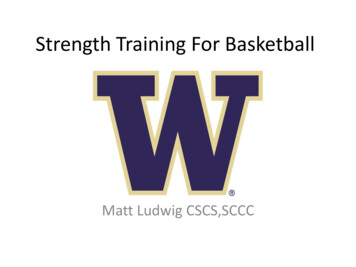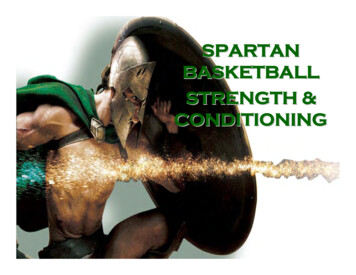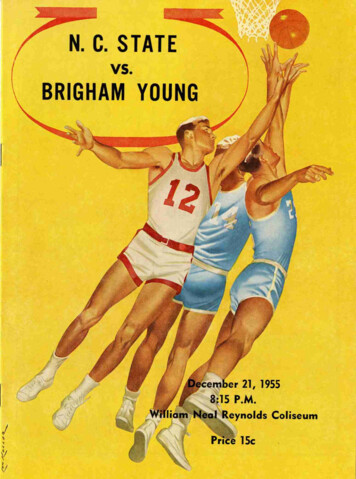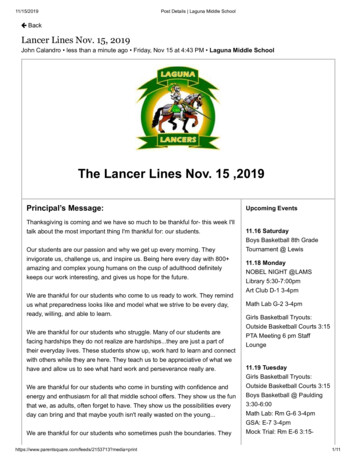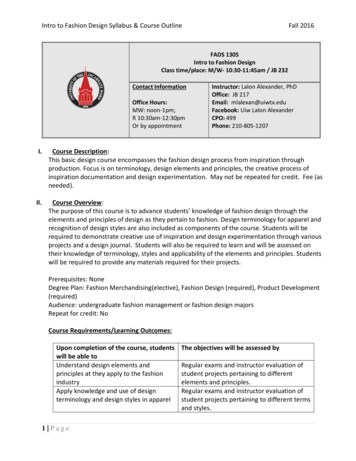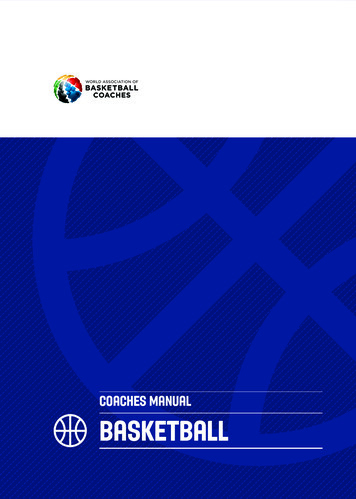
Transcription
coaches manualBasketballCoaches manual01
Coaches manual02
world association of basketball coachesBasketballMessage from Secretary General of FIBA02Message from President of WABC031Introduction1.11.2About this resourceQuick history of basketball2Basic rules of basketball2.1Substitutions and time-outs072.2Playing the game082.3Violations092.4Timing violations112.5Fouls123Glossary of terms3.1Understanding diagrams used in this book133.2Glossary of common basketball terms154Introduction to Coaching4.1The coach’s starting point334.2The coach’s responsibilities350406Coaches manual01
BasketballMessage from Secretary General of FIBAPATRICK BAUMANNSecretary General of FIBAFIBA fully appreciates the enormousimportance of basketball in thedevelopment of young people andof the fundamental role played bycoaches within this context. They arethe ones who, by working daily withplayers, must make the experience ofplaying basketball a beneficial one formen, women, boys and girls alike. Assuch, the objective of FIBA’s coachingprogramme for young players is to teachcoaches how to best understand andtake charge of their responsibilitieswhile also learning concepts andstrategies which allow them tosuccessfully develop this undertakingwith the boys and girls who depend somuch upon them.I was privileged to chair the workinggroup that produced the book Basketballfor Young Players, one of the mostimportant resources for teachingbasketball. Since it was first published in2000, basketball has continued to growthroughout the world and FIBA nowhas 215 affiliated national federations,which means that millions of players arededicated to the practice of our sport.Coaches manualMany of these players are children andteenagers for whom basketball can bean excellent educational opportunityfor their athletic, personal and socialdevelopment. Among other things,basketball should serve to developvalues that help make future adultsbetter citizens, stimulating the peacefuland respectful coexistence of thepeople and countries of the 21st century.There have been plenty ofadvancements and changes in manyaspects of our sport - and societyin general - since the original bookwas published. In 2011, the WorldAssociation of Basketball Coaches(WABC) introduced a series of GlobalCoaching Clinics which has enabledthousands of coaches to keep up todate with current trends and practices.This book, in conjunction with thoseclinics, will provide readers with themethodology and pedagogy to makea difference in the lives of youngbasketball athletes around the world.02
BasketballMessage from President of WABCPATRICK HUNTPresident, World Association of Basketball Coaches (WABC)The aim of the World Associationof Basketball Coaches (WABC) is toimprove the standard of the gamethrough improving the standard of thoseteaching the game. This book, alongwith resources such as the GlobalCoaches Clinics introduced in 2011,is designed to be a basis from whicheach coach can build their owncoaching philosophies.The role of a basketball coach is notsimply to improve the skills of eachplayer and their understanding of thevarious tactics of the game. A coach’srole extends to developing eachathlete as a person. Particularly whencoaching young athletes, a coachshould seek to instil a love of the gamein each player and a desire to play andlearn about the game.It has been an absolute pleasure to bethe Editor in Chief and chair the WorkingGroup for this book. I am most gratefulfor the outstanding contribution of theworking group which complements andfurther enhances the fine work of theoriginal Authors.The book provides an outstandingresource for coaches at all levels andunderpins key WABC events includingGlobal Coaches clinics, our FIBA coachingweb-site and social media platforms.FIBA and the WABC remain committedto developing and supporting coachesand we are pleased this resource willreinforce that commitment and resolve.Coaches manualLearning is a change in behaviour due toan experience. Coaches are responsiblefor providing enriching experiencesfrom which players will improve andflourish. This book will provide coacheswith information and techniques tonot only enhance players skills andunderstanding but will also help shapeplayers’ characters and teach valuesthat lead to success in life and ourwonderful Global game.Coaching junior basketballers isdifferent from coaching a professionalteam and different again from coachingadult athletes. Indeed, each athlete isdifferent and the coach must have theskill to assess the developmental needsof each player and to address each ofthose needs, within the context of theoverall team.Coaches of junior players must becognisant of the physical, emotionaland social development of each oftheir players and must be able to take alonger term view towards actions thatare taken every day.It is a challenging role, but it is animmensely rewarding one.I recommend this book to all coaches.03
Basketball1. Introduction1.1 About this resource1introduction1.1About this ResourceIn 2000 FIBA produced an excellent book which wasaimed at developing the coaches of young basketballathletes. This book, Basketball for Young Players,formed the basis of FIBA’s programme for teachingthe skills and tactics of basketball.Current Secretary-General of FIBA, MrPatrick Baumann and Mr Anton MariaComas (then President of the EuropeanAssociation of Basketball Coaches)chaired the working group thatproduced the book. The authors of thatbook were Mr Aleksander Avakumovic,Dr Maria Buceta, Mr Maurizio Mondoniand Mr Laszlo Killik and it is testamentto their expertise that the book hasremained one of the most importantresources in basketball developmentsince its publication. It has beentranslated into several languagesIn 2013 this publication was reviewedby the World Association of BasketballCoaches, chaired by Patrick Huntand Zoran Radovic, FIBA’s SportDevelopment Director. The reviewconfirmed the book as still an excellentresource for coaches, however, itidentified a need for it to be substantiallyrevised on account of: Changes in technical and tacticalaspects of the game; Advancements in various areas,particularly in Sports Scienceand Medicine; Impact of rule changes, includingnew keyways, block/charge circle;The WABC commissioned a workinggroup to produce this resource forcoaches of young basketballers, drawingupon the previous book as required.Accordingly, this book is a new work,however many of the themes of theprevious book also remain current.Patrick Hunt acted as Editor in Chief forthis book, and the primary writer of thebook was Michael Haynes who was alsothe editor. The book has contributionsfrom Neil Gliddon, Peter Lonergan,Michael Haynes, Patrick Hunt, DavidMunns and Zoran Radovic. FlorianPasquet, (National Federations & SportSenior Associate with FIBA) managedand designed the book and lead thedevelopment of the accompanyingonline resource, assisted again byMichael Haynes.FIBA would also like to thank the othermembers of the Executive of the WorldAssociation of Basketball Coaches, fortheir invaluable contribution to this book: Mr Brooks Meek, Mr Michael Schwarz Mr Milan Opacic Mr Veselin Matic Accessibility of various technologiesfor coaches.Coaches manual04
Basketball1. IntroductionSport can develop self-confidence, selfconcept, self-esteem and self-control andprovide players with positive experiencessuch as having fun, feeling competentand receiving the appreciation of othersand, of course, to the development of thebasketball skills of the young player.As such, sport plays a very importantrole in the athletic and humandevelopment of young people and“coaches contribute to the developmentof athletes as people, teams as cohesiveunits and communities with a sharedinterest. Coaching can also contributeto social aims by promoting activityand health.” 1This book sets out the material used inFIBA’s coach education programme: Level 1 – for coaches of juniorathletes at Club level; Level 2 – for coaches of juniorathletes at Regional level; Level 3 – for coaches of juniorathletes at National level.1.1 About this resourceThe book explores the role of the coachand looks closely at the coach-athleterelationship, encouraging the coach tounderstand that what they do is as, if notmore, important than what they say andto understand their own personality andphilosophies and to consider how thatimpacts upon them as a coach.The book recognises that every athleteis an individual and discusses thedifferent ways people learn and howdifferent personalities impact upon howto best teach that athlete. Central toFIBA’s philosophy is that “a coach whounifies a group for a common purpose orprovides skills for lifelong participationis every bit as successful as the leaguetitle winning coach”. 2One of the primary responsibilitiesof a coach “is the protection of andrespect for the integrity and individualityof those with whom coaches work.Coaches have a particular responsibilityto safeguard and protect children andyoung people in their care”. 3The book is not confined to justcoaching junior athletes and manytopics are also explored in the contextof coaching senior athletes.As a final thought:“The challenge to maximize effectiveness with various groupsof athletes and changing circumstances is part of the allureand richness of coaching. Because of the diversity of the roleand contexts, the delivery of coaching and what is deemedsuccessful will always be situation specific.” 41 International Sport Coaching Framework, p6, 2013,Human Kinetics2 International Sport Coaching Framework, p13, 2013,Human Kinetics3 Ibid, p174 International Sport Coaching Framework, p14, 2013,Human Kinetics.Coaches manual05
Basketball1.21. Introduction1.2 Quick history of basketballQuick History of basketballBasketball was created by Dr James Naismith in 1891 asa sport that could be played indoors by young men at theSpringfield YMCA in Massachussets.The first game involved9 players on each sidevying to throw a soccerball into a peach basket,which was nailed on thewall of the gymnasium,10 foot (3.048m) fromthe floor.The game grew quickly and whilst thenumber of players has reduced to 5 perteam, the “basket” is at the same heightand the ball is still round! Initially, therewere 13 rules and many of them continueinto the current rules. Some changesthat were not in the original rules are: The backboard:the original gymnasium had a balcony, fromwhich spectators could watch the game.The backboard was introduced to stopthese spectators from blocking shots! Dribbling:the original rules stated that a player hadto pass the ball from the spot where theycaught the ball. Players soon startedto “move” with the ball by droppingthe ball, changing position, and thencatching it again. In 1901 players could dribble the ball once(but could not then shoot) and in 1909unlimited dribbling was allowed. Screening:this was never prohibited under the rules.The first screens however were caused bypillars that were supporting the roof andwere in the playing area! Basketball nets:Dr Naismith used peach baskets as thetarget, and someone had to climb a ladderand get the ball out after each basket.Thankfully, scores were relatively low(the first game was won 1-0). The next evolution was to make a smallhole in the bottom of the peach basket,so that a piece of wood could be pushedthrough to push the ball out. In 1901, a netwas used (rather than a basket) so that theball would go straight through!Coaches manualOne of the most populargames in the worldThere are currently 215 countriesaffiliated with FIBA, which is theinternational body responsible for thegrowth and development of basketball.This makes basketball one of the mostpopular sports in the world.Basketball is both an Olympic (Mensince 1936, Women since 1984) anda Paralympic Sport (Men since 1960,Women since 1968). And the newestdiscipline in the sport (3x3) is playedin the Youth Olympic Games and isunder consideration to be played atthe Olympics.FIBA conducts The Men’s World Cup theWomens World Championships everyfour years and World Championshipsfor U17 and U19 Men and Women areconducted very two years.FIBA has introduced a professional3x3 world tour, as well as conducting3x3 World Championships for juniorsand seniors.06
Basketball2.Basic rules of basketball2.1 Substitutions and time outs2 basic rulesof basketball2.1Substitutions and Time OutsBasketball is played by two teams, each with five playerson the court at any one time. Each team may haveadditional players (substitutes) that can be interchangedan unlimited number of times.If a player accumulates 5 personal fouls in one game theycan take no further part in the game. Similarly, players canbe sent off (for example when they receive two technicalfouls). If they are sent off, the player must leave theplaying area. If they are “fouled out”, they may remainon the team bench.Substitutions can only be made whenthe game is stopped, and is done by thescoretable notifying the referees of therequest to substitute a player. The coachshould have players that are to go intothe game “report” to the scoretable andrequest a substitution. It should not bethe coach that asks for a substitution,although often times a coach will makethe request. The reason for playersasking for the substitution is so that thescoretable can ensure that the player iscorrectly entered on the scoresheet andeligible to play.Some local competitions may havevariations to the rules in regards towhen substitutions can be made andcoaches should be familiar with therules of each specific competition inwhich they compete.Coaches manualBasketball is played in four quartersand there is a short break between eachquarter (the break at half time is longer).In addition, coaches may call a time-out,which provides a 1 minute break duringwhich they may address their team.The coach asks the scoretable torequest a time-out and the scoretablenotifies the referees.Competitions will often vary whentime-outs may be called and how manytime-outs a coach may call. Coachesshould make sure they are familiar withthe rules of the particular competition inwhich they are competing.07
Basketball2.22.Basic rules of basketball2.2 Playing the gamePlaying the GameThe coach must ensure that their players know the rules ofbasketball and that they teach skills in a way that adheresto“legal” execution within the rules. A summary of some keyrules is included in this chapter.The game is played by two teams: Teams have 5 players each on the court T eams may have another 5-7 playerswho are substitutes. There is an unlimited number ofsubstitutions, however any substitutionmust be done during a break in play andis administered by the officials. Playerscannot simply run on and off. A “foul” is called if there is unlawfulcontact. A player that has 5 fouls cannottake any further part in that game (in somecompetitions players may have 6 fouls).Teams score points by shooting the ballinto their opponent’s basket. The ballmust enter the basket from above andmust pass through the basket to count.There is an arc on the court and a shotfrom outside this arc (if successful) isworth 3 points. All other shots takenduring play are worth 2 pointsif successful.A player may also be awarded 1, 2 or 3“free throws” and these are worth onepoint each if successfully made. Freethrows are awarded as a result of a foulbeing called:- for contact on an offensive player that isin the act of shooting;- for contact on any player if the teamcommitting the foul has alreadyaccumulated 4 fouls in the quarter.When a team scores, their opponent isawarded the ball to be thrown in fromthe baseline. The team has 5 secondsto throw the ball into play. The refereedoes not need to touch the ball.Players may venture to any part of thecourt and all players may use the ball inthe same way during the game. Whenmoving around the court: The sidelines and endlines are out ofbounds. If a player has the ball and standson the line, the ball is out of bounds. When a player jumps, while they are in theair, they are regarded as being on the spot ofthe floor where they jumped. It is only whenthey land that they are on another spot on thefloor. Some practical examples of this are: If a player is standing in court and jumpsto stop a ball from going out of bounds.If they catch the ball while they are inthe air (even if the ball has crossed theline), they can throw the ball back intoplay. Because they jumped from insidethe court, the ball is not out of bounds. Similarly, if a player is standing outsideof the court and jumps into the court,catching the ball while they are in theair. The ball is out of bounds (even if theplayer had crossed the line) because theplayer jumped from outside the court andis regarded as being outside until theyhave landed in court. If a player has the ball outside the 3 pointline, jumps in the air to shoot the ball (andreleases the ball while in the air) and thenlands inside the 3 point line, the shot isworth 3 points if successful.Coaches manual08
Basketball2.32.Basic rules of basketball2.3 ViolationsViolationsIt is worthwhile for players and coaches to do an introductoryreferee course so that they have both a good understandingof the rules and they also appreciate how difficult thereferee’s role is.The main violations that occur inbasketball are: Travelling; Illegal dribble; “Cross court” violation.TravellingBasketball is a very dynamic game andplayers can move with the ball, providedthat they are “dribbling”. This ensuresthat basketball is a fast moving game.It is critical that all players understand thesignificance of their pivot foot and candetermine which foot is their pivot foot.Whenever a player catches a ball, theofficial will determine which is their pivotfoot, according to the following rules: If the ball is caught while the player hasboth feet in the air, the first foot that landson the floor is their pivot foot; If the ball is caught while the player hasboth feet in the air and they land withboth feet at the same time - the player canchoose which foot to use as their pivot.When they lift one foot, the other footautomatically is their pivot foot. If the ball is caught while a player has onefoot on the floor, that is their pivot foot. If the ball is caught while a player has bothfeet on the floor, they can choose which istheir pivot foot.Coaches manualThe significance of the pivot foot is: If the player wants to dribble, the ball mustleave their hand BEFORE their pivot footleaves the floor. If the player lifts their pivot foot, they musteither pass the ball or shoot it BEFOREputting their pivot foot back on the floor.Breaching either rule is a travellingviolation. It should be noted that in manyprofessional leagues, players are givenleniency in regards to travelling. However,coaches should teach their players tomove with the ball without travelling.Illegal DribbleA player with the ball can move if theyare dribbling. Dribbling is when theball is bounced with one hand onto thefloor. Putting two hands on the ball endsthe dribble. The player can change thehand they are dribbling with, but afterthe ball hits one hand it must hit thefloor next to be a valid dribble. The handdribbling the ball should be on the top oron the side of the ball. Any dribble stopsif the ball comes to “rest” in the player’shands (e.g. if they had their hand underthe ball). If the player keeps dribbling,this is a violation.09
Basketball2.Basic rules of basketball“Cross Court” violationThe team is divided into two sections bythe “half way” line. The front court isthe end where a teams is trying to score.Their “back court” is the end where theyare defending and trying to stop theiropponent from scoring.2.3 ViolationsOnce the ball is in a team’s front court,it cannot be taken back into the team’sback court. The ball is regarded asbeing in the front court when: The ball is passed to (and caught by!)a player that has one or two feet in thefront court; When a player is dribbling across the halfway line, it is only in the front court whenboth of the player’s feet and the ball haveall touched the front court.Coaches manual10
Basketball2.42.Basic rules of basketball2.4 Timing ViolationsTiming ViolationsThere are a number of specific timing violations, althoughoften in local competitions they may not be enforced ormay be enforced with leniency. Coaches should checkwith the administrator of the competition as to whichspecific rules will be applied.The timing violations are:3 seconds14 secondsOnce a team has the ball in their frontcourt, an offensive player cannot bein the “key” for more than 3 seconds.When a shot is taken, the 3 secondcount stops. If a player steps out ofthe key (with both feet) they can thenre-enter the key and have another 3seconds.A team that takes an offensive reboundwill then only have 14 seconds in whichto attempt a shot5 secondsThe 14 and 24 seconds violationsare often not used in local or juniorcompetitions. A separate “shot clock”is used to count this time and requires adedicated timekeeper who just operatesthe “shot clock”.A player with the ball that has anopponent guarding them closely mustpass, shoot or dribble within 5 seconds8 seconds24 secondsWhen a team first has possession of theball, they have 24 seconds in which toattempt a shot.The offensive team cannot take morethan 8 seconds to move the ball fromtheir back court into their front court.Coaches manual11
Basketball2.52.Basic rules of basketball2.5 FoulsFoulsBroadly, there are three types of fouls: Illegal contact Unsportsmanlike contact – when a playermakes contact with an opponent and theofficial believes that they were not actingin a sportsmanlike fashion Technical Foul – when a player acts inan unsportsmanlike fashion, but withoutmaking contact with another player (e.g.disputing a referees decision).In any game of basketball there is a lotof contact between players. Some keyconcepts to determine if the contact islegal are: A person standing in the path of anopponent. However, if the opponent doesnot have the ball, the person has to givethem sufficient opportunity to avoidthe contact. A player should not extending their arms orlegs outside of their “cylinder”: Effectivelythis is, effectively the width of their body.If they reach with their arms or legs andcontact is made beyond their hips orshoulders, it will likely be their foul. If the player has good defensive positionwhich a defender must have established,with both feet on the court (beforethe contact). They must be facing theiropponent and have established thisposition before their opponent makesCoaches manual12
Basketball3.Glossary of terms3.1 Understanding diagrams in this book3Glossary of terms3.1Understanding diagramsin THIS BOOKThe following symbols are used in the diagramsin this book:Cx1x11CoachCoaches often need to be actively involved in practice sessions, for example asa passer or defender.Coneor MarkerThis is placed on the court to designate a spot on the floor. It may identify a reduced areaon the court for an activity or it may signify where an athlete should be.Hand OffA player runs past a teammate that has the ball and is given the ball. They run closeto their teammate and the teammate holds the ball with one hand on top and one handon the bottom. This makes it easier for the teammate to grab the ball.The defensive player is numbered to show both who they are defending (Player 1)and also their position:DefensivePlayer1. Point Guard2. Shooting / Off Guard3. Small Forward4. Power Forward5. CentreA defensive player may be shown on an angle, to represent a direction they face.In the example shown, the defender is facing the left hand side of the page.PlayerA number usually signifies an offensive player and again, the number may indicateposition. In some activities however, the number may simply designate a sequencefor players to be involved in.PassThe dotted line shows the path of a pass, here from Player 1 to Player 2.It is also used to designate a shot, when pointing to the basket.PlayerDribblingThe path of a player dribbling is shown by a zig-zag line.PlayerMovingThe path of a player moving on the court is shown by an arrow.Playerwith the BallA player with the ball is shown either as a circled number or by the use of a small dotnext to the player.This is also used if, for example, a coach has a ball.Coaches manual13
BasketballScreen /Block Out /double-team33.Glossary of terms3.1 Understanding diagrams in this bookA screen is shown by a vertical line at the end of a horizontal line. The horizontal lineshows the path that the player setting the screen moves along on the court.Also used to show a defender “blocking out” an offensive player in a rebounding contest.Finally, it is used to show defensive players that are double teaming or “Trapping” a playerwith the ball.The position of a player’s feet are shown with two dots.12Player’sfeetMovement of feet is shown with arrows and numbering.A pivot is shown as only one foot moving.Coaches manual14
Basketball3.23.Glossary of terms3.2 Glossary of common basketball termsGlossary of commonBasketball TermsWhere on the Court is it?CornerLow Postor”Block”WingShortCornerElbowGuard or “Point”Split LineHigh PostKeywayNo ChargeCircleEndline or BaselineAreas on the court that coaches commonly refer to:Elboweither end of the free throw line;High Postat the foul line;Low Post or “Block” where the offensive rebounder lines upduring a foul shot;Short Corner between the key and the 3 point line,opposite the basket;Wingat the 3 point line, opposite thefree throw line;Split Line the middle of the court. The “line” isimaginary going from one basketto the other.Pointis the area at the top of the key.Coaches manual15
Basketball3.Glossary of terms3.2 Glossary of common basketball termsWhat do Words Mean?“1 Pass Away”, “2 Passes Away” etc.The number of “passes away“ anoffensive player is from the ball, is usedto define the position of their defender.It describes how close the offensiveplayer is to the ball. Generally, the closeran opponent is to the ball, the closer thedefender needs to be to them. Player 1 has the ball.52 Player 5 is “three passes away”x4x21 pass1x3x11 pass Player 4 is “two passes away”3 passesx5 Players 2 and 3 are “one pass away”42 passes3 Player 2 has the ball Players 1 and 5 are “one pass away”5x52 Player 3 is “two passes away”x4 Player 4 is “three passes away”x24x3x113Coaches manual16
Basketball3.Glossary of terms3.2 Glossary of common basketball termsActive HandsWhen defending the person with the ball, the defender should keep one hand infront of the ball and the other hand “active” to make it hard for player to pass theball. If the player is dribbling, keep the hand opposite the ball low to prevent acrossover and the other hand up to prevent a pass.However, a common mistake that defenders make is to reach for the ball (takingthem off balance). “Active Hands” are in combination with moving the defender’sfeet: when the offensive player moves their feet, the defender must first movetheir feet.“Back Door” CutA “Back Door” cut is a quick cut, usually toward the basket. The cut is performed ifa player is being denied and cannot receive a pass.3x3 Step away from basket, showing hand (as a passing target) Push off the foot that is furtherest from the basket and cut to the basket.Do NOT take only one or two steps1A “back cut” can also be performed off a screen.x33The defender may step in the path of the cutter so that they cannot go over the topof the screen. The cutter steps into their defender (as if cutting over the top of thescreen) and then changes direction to “back cut” towards the basket.2Coaches manual17
Basketball3.Glossary of terms3.2 Glossary of common basketball termsBall ReversalBall reversal is moving the ball from one side of the court to the other.It is usually done by passing, however dribbling can be used. It is also referred to as“swinging” the ball.431Young players may need to make several passes to move from one side of the courtto the other.2Older players will be able to throw passes over a longer distance, so may “reversethe ball” in less passes.4312A pass from one wing to the other is a type of ball reversal and is called a “SkipPass”. It takes a lot of strength (particularly in the tricep muscle) to throw this passand most young players cannot throw it effectively.4312Coaches manual18
Basketball3.Glossary of terms3.2 Glossary of common basketball terms“Big to Bigger” (or “Defensive Slide”)LeftLeft2ndrightright1st“Big to Bigger” is used to describe defensive footwork.When moving laterally toguard someone with the ball, defenders shouldbe taught to use “big to bigger”footwork, sometimes called “defensive slide”. The premise is simple – when movingto your right, step with the right foot first. The second step brings you back to abalanced stance.This footwork is important to “take a charge” or to contain a dribbler. However, thefootwork is slower than running and defenders may only take one or two steps beforethey need to change to running to be able to stay in front.“Box Out” or “Block Out”When a shot is taken, each defender must first make contact with their player and stopthem from rebounding. This is called “boxing out”. Players should box out 1-2 metresaway from the basket. If they are too close to the basket the rebound will bounce overtheir head.Bump the Cutter“Bumping” the cutter is simply getting in the way of a person cutting into the keywayto stay between them and the ball and to make them cut behind the defenderChannelling the DribblerTo “channel” a dribbler, the defender should be in front of the dribbler with the footclosest to the dribbler approximately at the dribbler’s shoulder.Step acrosstheir path ifthey try to goto the middleThe hand closest to the dribbler should be low (to stop a cross-over dribble) and theoth
4 International Sport Coaching Framework, p14, 2013, Human Kinetics. Basketball 1. Introduction 1.1 About this resource. Coaches manual 06 1.2 Quick History of basketball Basketball was created by Dr James Naismith in 1891 as
